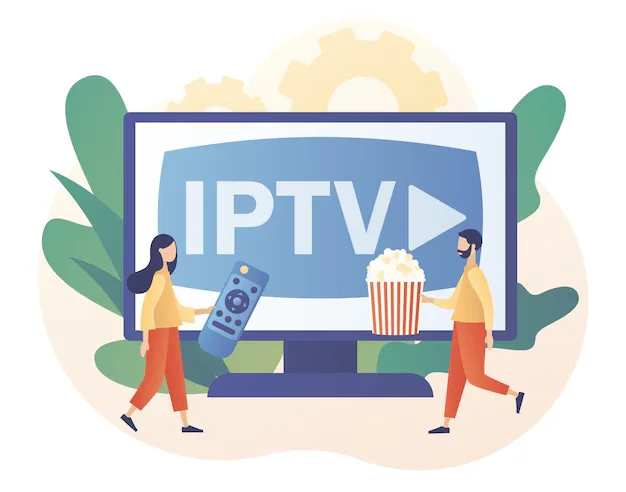IPTV DVR: The Complete Guide to Recording Your Favorite Shows
Have you ever missed your favorite show because you weren’t home in time? Or wished you could pause live TV when something unexpected comes up? IPTV DVR technology solves these common viewing frustrations by bringing powerful recording capabilities to your streaming experience. Unlike traditional cable DVRs, IPTV recording solutions offer greater flexibility, more storage options, and seamless integration with your existing streaming setup.
IPTV (Internet Protocol Television) has transformed how we consume television content, and adding DVR functionality takes this experience to the next level. But what exactly makes IPTV DVR different from traditional recording methods? How can you set it up? And what features should you look for when choosing an IPTV service with DVR capabilities?

In this comprehensive guide, we’ll explore everything you need to know about IPTV DVR – from basic functionality to advanced features, setup instructions, and tips for maximizing your recording experience. Whether you’re new to IPTV or looking to enhance your current setup with recording capabilities, this article will provide all the information you need to make informed decisions about your entertainment options.
What Is IPTV DVR and How Does It Work?
IPTV DVR (Digital Video Recorder) is a feature that allows you to record live television programming delivered through an internet connection rather than traditional cable or satellite methods. But how exactly does this technology work? At its core, IPTV DVR functions by capturing the digital video stream and storing it either locally on your device or in cloud storage for later viewing.
Unlike traditional DVRs that require specialized hardware boxes from your cable provider, IPTV DVR can operate through various devices including dedicated set-top boxes, smart TVs, computers, or even applications on streaming devices like the Fire TV Stick. This flexibility represents one of the major advantages of IPTV recording solutions.
When you schedule a recording, the IPTV DVR system marks that program in its electronic program guide (EPG) and automatically captures the content when it airs. The recorded content is then stored according to your system’s configuration – either on a local hard drive, network attached storage (NAS), or in cloud storage provided by your IPTV service.

But what makes IPTV DVR truly powerful is its ability to handle multiple recordings simultaneously without degrading performance. Traditional cable systems often limit how many shows you can record at once based on the number of tuners in your DVR box. With IPTV DVR, these limitations are largely eliminated since the recording happens at the server level in many cases, allowing you to record numerous programs simultaneously.
Another key difference is the integration with other streaming features. IPTV DVR systems typically allow for more seamless transitions between live TV, recorded content, and on-demand programming all within the same interface. This creates a unified viewing experience that traditional DVRs struggle to match.
The technology behind IPTV DVR continues to evolve, with providers like IPTV4Cheap offering increasingly sophisticated recording options as part of their service packages. These advancements have made time-shifted viewing more accessible and user-friendly than ever before.
Key Benefits of Using IPTV DVR for Your Entertainment Needs
Why should you consider adding DVR functionality to your IPTV subscription? The benefits extend far beyond simply recording shows you might miss. Let’s explore the advantages that make IPTV DVR an essential component of a modern entertainment setup.
First and foremost is the unparalleled flexibility in how you consume content. With IPTV DVR, you’re no longer tied to broadcasters’ schedules. Have dinner plans during your favorite weekly show? Record it and watch later that night, the next day, or whenever is convenient for you. This time-shifting capability puts you in control of your viewing schedule.
Storage capacity represents another significant advantage. While traditional DVRs often come with limited hard drive space, many IPTV DVR solutions offer expandable or even unlimited storage options. Some providers like IPTV4Cheap’s premium plans include cloud DVR with generous storage limits, allowing you to build an extensive library of recorded content without worrying about space constraints.

The multi-device accessibility of IPTV DVR content stands out as particularly valuable in today’s connected households. Record a show on your living room TV and watch it later on your tablet in bed, or start watching on one device and continue seamlessly on another. This cross-device functionality aligns perfectly with modern viewing habits.
Advanced playback controls enhance the viewing experience significantly. Beyond basic pause and resume functions, many IPTV DVR systems offer commercial skipping, scene jumping, and variable playback speeds. These features let you customize how you watch recorded content, saving time and enhancing enjoyment.
For sports enthusiasts, IPTV DVR is particularly valuable. Can’t watch the big game live? Record it and avoid spoilers until you can watch. Many systems even allow you to record just the highlights or condensed versions of sporting events, perfect for catching up quickly on what you missed.
Finally, the cost efficiency of IPTV DVR solutions deserves mention. Adding DVR functionality to an affordable IPTV subscription typically costs significantly less than the DVR fees charged by traditional cable providers, while offering more features and flexibility.
Setting Up Your IPTV DVR System: A Step-by-Step Guide
Ready to start recording your favorite shows with IPTV DVR? The setup process varies depending on your chosen hardware and service provider, but this general guide will walk you through the essential steps to get your system up and running quickly.
Before beginning, you’ll need to ensure you have a compatible IPTV subscription that includes DVR functionality. Not all providers offer this feature, so check with services like IPTV4Cheap to confirm DVR capabilities are included in your plan. You’ll also need a supported device – this could be a dedicated IPTV box, a compatible smart TV, or a streaming device like a Fire Stick with the appropriate IPTV application installed.
Start by installing your chosen IPTV application if you haven’t already. Popular options include IPTV Smarters Pro, which offers robust DVR support. The installation process varies by device, but many providers offer detailed setup guides. For Fire Stick users, you can follow this step-by-step installation guide to get started.

Once your application is installed, you’ll need to configure your storage settings. If your app supports local recording, you’ll need to connect and format an external storage device like a USB drive or SD card. For cloud DVR, this step may not be necessary as recordings are stored on the provider’s servers. Navigate to the settings menu in your IPTV app to specify your preferred storage location and configure options like recording quality and default recording length.
Next, familiarize yourself with the electronic program guide (EPG) in your IPTV application. This interface displays the schedule of upcoming programs and allows you to select shows for recording. In most applications, you can schedule recordings by selecting a program in the guide and choosing the record option. Many apps also support series recordings, which automatically capture every episode of a show as it airs.
For more advanced configurations, explore additional settings like buffer times (which start recordings a few minutes early and end them a few minutes late to avoid missing content), conflict resolution (determining which shows take priority when scheduling overlaps occur), and storage management options (automatic deletion of old recordings when space runs low).
If you encounter issues during setup, most providers offer detailed setup guides and customer support. Don’t hesitate to reach out if you need assistance configuring your DVR functionality properly.
Comparing Cloud DVR vs. Local Storage Options for IPTV
When setting up your IPTV DVR system, one of the most important decisions you’ll face is choosing between cloud-based recording and local storage solutions. Each approach has distinct advantages and limitations that might make it more suitable for your specific needs.
Cloud DVR stores your recordings on remote servers maintained by your IPTV service provider. The primary advantage here is accessibility – you can access your recordings from any device with an internet connection, anywhere you go. There’s no need to worry about local storage capacity or hardware failures, and setup is typically simpler since there’s no additional equipment to configure. Services like IPTV4Cheap’s monthly plans often include cloud DVR options with varying storage limits.
However, cloud DVR does have potential drawbacks. Your ability to access recordings depends on having a stable internet connection. Additionally, providers may impose storage limits or retention periods (how long recordings remain available before automatic deletion). Privacy concerns also arise, as your viewing habits and recorded content are stored on third-party servers.

Local storage, by contrast, keeps recordings on physical media you control – typically an external hard drive, NAS device, or the internal storage of your IPTV box. This approach gives you complete control over your content with no imposed limits on storage capacity beyond what your hardware can support. Your recordings remain accessible even without an internet connection, and you maintain full privacy over your content library.
The disadvantages of local storage include the upfront cost of storage hardware, potential technical complexity in setup, and limited accessibility (recordings are typically only available on the device connected to the storage media). Additionally, you’ll need to manage your own storage space and implement backup solutions to protect against hardware failures.
Some advanced users opt for a hybrid approach, using cloud DVR for everyday recordings and temporary content while maintaining a local storage system for archiving favorite shows or movies they want to keep permanently. This combination provides flexibility while mitigating the limitations of each individual approach.
When making your decision, consider factors like your technical comfort level, budget constraints, privacy preferences, and how you typically access your content. If you frequently watch on multiple devices or while traveling, cloud DVR might be preferable. If you have a fixed viewing location and prioritize control and privacy, local storage could be the better choice.
Advanced IPTV DVR Features You Should Know About
Modern IPTV DVR systems offer sophisticated features that go well beyond simple recording capabilities. Understanding these advanced functions can help you get the most out of your setup and enhance your viewing experience significantly.
Series recording (sometimes called season pass) automatically captures every episode of a show as it airs, eliminating the need to manually schedule each recording. More advanced implementations can even detect and avoid recording reruns, ensuring you only capture new episodes. This feature is particularly valuable for keeping up with weekly shows without constantly managing your recording schedule.
Intelligent conflict resolution represents another powerful capability in premium IPTV DVR systems. When scheduling conflicts occur (multiple shows airing simultaneously that you want to record), advanced systems can automatically prioritize recordings based on your preferences or viewing history. Some services even leverage cloud recording to eliminate conflicts entirely by allowing unlimited simultaneous recordings.

Enhanced playback controls significantly improve how you interact with recorded content. Beyond basic pause and resume, look for features like automatic commercial skipping, chapter markers for navigating between segments of a program, and variable speed playback (watching at 1.5x speed to get through content faster). These controls give you more control over your viewing experience and can save considerable time.
Remote scheduling capabilities allow you to set up recordings even when you’re away from home. Many providers offer web portals or mobile apps that connect to your DVR system, enabling you to browse the program guide and schedule recordings from anywhere with internet access. This proves especially useful when you’re out and hear about a show you don’t want to miss.
AI-powered recommendations represent the cutting edge of IPTV DVR technology. These systems analyze your viewing habits and recording patterns to suggest additional shows you might enjoy and even automatically record them based on your preferences. While not universally available yet, this feature is becoming more common in premium IPTV subscription services.
Multi-user profiles allow different household members to maintain separate recording libraries and preferences. This prevents one person’s recordings from cluttering another’s library and enables personalized recommendations for each user. For families with diverse viewing preferences, this feature proves particularly valuable in keeping content organized.
Troubleshooting Common IPTV DVR Issues and Solutions
Even the best IPTV DVR systems occasionally encounter problems. Knowing how to identify and resolve common issues can save you frustration and ensure you don’t miss your favorite programs. Let’s explore the most frequent challenges and their solutions.
Recording failures represent one of the most common complaints. If your system isn’t capturing scheduled programs, first verify your subscription status – some providers temporarily disable DVR functionality if payments are overdue. Next, check your storage capacity; insufficient space often causes recording failures. For cloud DVR users, confirm you haven’t exceeded your storage allocation. If these basic checks don’t resolve the issue, try rebooting your device and updating your IPTV application to the latest version through the official download channels.
Playback problems like stuttering, buffering, or poor video quality can ruin the viewing experience. These issues typically stem from network limitations rather than the DVR system itself. Start troubleshooting by checking your internet connection speed – most HD recordings require at least 10Mbps for smooth playback. Try connecting your device via ethernet rather than WiFi if possible, as this provides more stable connectivity. If problems persist, lower the playback quality settings within your IPTV application to reduce bandwidth requirements.

Missing program information in your guide makes scheduling recordings difficult. If your electronic program guide (EPG) shows incomplete data or “No information available” messages, try forcing a guide update through your application settings. Most services refresh guide data automatically, but manual updates can resolve temporary issues. If problems persist, contact your provider as the issue may be on their end.
Storage management challenges emerge as your recording library grows. Implement a regular maintenance routine by reviewing and deleting watched content you no longer need. Many applications offer auto-deletion settings that remove watched content after a specified period or when storage space runs low. For local storage users, consider upgrading to a larger external drive if you frequently run out of space.
Scheduling conflicts occur when you attempt to record more simultaneous programs than your system supports. Resolution depends on your specific setup – cloud DVR users should check how many concurrent recordings their subscription allows through their service plan details. Local recording users may be limited by hardware capabilities. In either case, prioritize your most important shows and consider upgrading your subscription or hardware if conflicts occur frequently.
If these troubleshooting steps don’t resolve your issues, don’t hesitate to contact your IPTV provider’s customer service. Most reputable services offer technical support specifically for DVR-related problems.
Maximizing Your IPTV DVR Experience: Tips and Tricks
Now that you understand the basics of IPTV DVR and have troubleshot common issues, let’s explore strategies to get the absolute most from your recording system. These expert tips will help you create a more organized, efficient, and enjoyable viewing experience.
Create a strategic recording schedule to maximize efficiency. Rather than randomly recording shows as you discover them, take time to plan your recording strategy. Many viewers dedicate specific times each week to review upcoming programs and schedule recordings. Consider using series recordings for regular shows and manual recordings for special events or movies. This proactive approach ensures you capture everything important without cluttering your library with content you may never watch.
Organize your recordings into folders or categories for easier navigation. Most advanced IPTV applications support content organization – you might create separate categories for different family members, genres, or viewing priorities (must-watch vs. background viewing). Taking time to implement an organization system pays dividends when you’re searching for specific content later.

Optimize recording quality settings based on your specific needs. While higher quality recordings look better, they consume significantly more storage space. For news programs or casual viewing, consider using standard definition settings to conserve space. Reserve high-definition or 4K recording for visually impressive content like nature documentaries or action movies where quality truly matters.
Leverage multi-device capabilities by setting up your IPTV DVR service across various platforms. With providers like IPTV4Cheap offering multi-connection plans, you can access your recordings from smartphones, tablets, smart TVs, and computers. This flexibility allows you to start watching in one location and continue seamlessly elsewhere.
Explore integration with other streaming services for a unified viewing experience. Some advanced IPTV applications can aggregate content from multiple sources, including your DVR recordings, live TV, and popular streaming platforms. This integration creates a seamless content ecosystem where everything you watch lives in one interface.
Consider implementing automated backups if you use local storage for recordings. External drives can fail, potentially causing you to lose your entire content library. Regular backups to a secondary storage location protect your recordings from hardware failures. For particularly valuable content, some users maintain redundant recording schedules across multiple devices as an additional safeguard.
Finally, stay informed about new features and updates to your IPTV DVR system. Providers regularly enhance their offerings with new capabilities, and staying current ensures you benefit from the latest improvements. Follow your provider’s social media channels or subscribe to their newsletter for announcements about system enhancements.
The Future of IPTV DVR Technology: What’s Coming Next
The world of IPTV DVR continues to evolve rapidly, with new technologies and capabilities emerging regularly. Understanding these trends can help you make informed decisions about your current setup and future upgrades. Let’s explore what innovations are on the horizon for IPTV recording technology.
AI-powered content analysis represents perhaps the most exciting frontier. Future DVR systems will likely incorporate sophisticated artificial intelligence that can automatically identify and tag content within recordings. Imagine searching your library for “beach scenes” or “car chases” and having the system instantly locate those moments across all your recordings. This granular content analysis will transform how we organize and access our media libraries.
Cross-platform synchronization will become more seamless in upcoming generations of IPTV DVR technology. While current systems offer some multi-device capabilities, future implementations will likely feature perfect synchronization across all your devices – automatically remembering exactly where you stopped watching on any device and resuming from that precise moment on another, even across different operating systems and platforms.
![]()
Expanded storage options will address one of the persistent limitations of current DVR systems. Cloud storage will likely become more affordable and expansive, with some providers potentially offering unlimited recording capacity as a premium feature. For local storage enthusiasts, integration with next-generation storage technologies will provide faster access and greater reliability for your growing content library.
Enhanced content discovery features will help solve the “what to watch” dilemma. Future IPTV DVR systems will likely incorporate more sophisticated recommendation engines that consider not just your viewing history but also trending content, critical reviews, and even your mood or available viewing time to suggest perfect content for any situation.
Integration with smart home ecosystems represents another promising direction. Imagine your DVR system automatically pausing when your doorbell rings, or dimming your living room lights when you start watching a recorded movie. As smart home technology becomes more prevalent, IPTV DVR systems will likely become key components in these connected environments.
Voice control and natural language processing will transform how we interact with our recording libraries. While basic voice commands exist in some current systems, future implementations will understand complex queries like “Record anything with Sandra Bullock that isn’t a romantic comedy” or “Find that documentary about penguins I started watching last week.” This natural interaction will make managing extensive recording libraries much more intuitive.
As these technologies develop, providers like IPTV4Cheap will likely incorporate them into their service offerings, continually enhancing the viewing experience. Staying informed about these advancements can help you make strategic decisions about your entertainment setup both now and in the future.